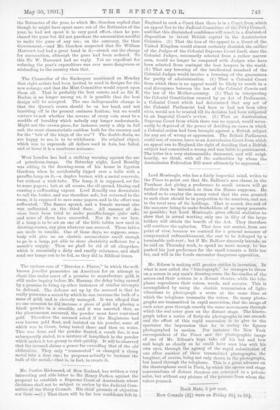Mr. Edison is making still greater strides in invention, In
what is now called the " kinetograph," he manages to throw on a screen in any man's drawing-room, the fac-similea of the actors and their actions in a distant theatre, while, the tele- phone reproduces their voices, words, and accents. This is accomplished by using the electric transmission of light- vibrations to photograph a scene at the same time at which the telephone transmits the voices. So many photo- graphs are transmitted in rapid succession, that the image of each actor goes through exactly the same movements through which the real actor goes on the distant stage. The kineto- graph takes a series of forty-six photographs in one second, and the effect of this rapid succession is to give to the spectator the impression that he is seeing the figures photographed in motion. For instance, the New York correspondent of the Times saw the photographic image of one of Mr. Edison's boys take off his hot and bow and laugh as clearly as he could have seen him with his own eyes, through the agency of the rapid substitution of one after another of these transmitted photographs, the laughter, of course, being not only shown in the photographs, but heard through the telephone. This is a great advance on the theatrophone used in Paris, by which the operas and stage conversations of distant theatres are conveyed to a private salon, but without any picture of the persons from whom the voices proceed.






































 Previous page
Previous page